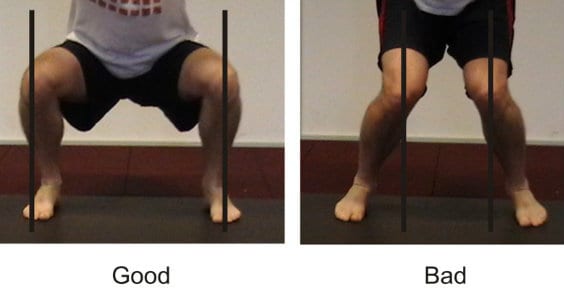By the healthiergang writer , student in Medicine and Surgery.
How to do squats?
Squatting (squatting) is a complex movement that we use every day in everyday activities, which is part of those 7/8 primitive patterns that each of us has in his or her motor baggage since birth.
It is a complex movement that does not involve just one muscle and joint segment but uses more muscle chains and more joints are involved (multi-joint).
The Movement Explained by the Expert
To better understand the gesture, the athlete is seated and given the right inputs to be able to get up without weighing on his back.
Another way to teach the movement correctly, making it as economical as possible from an energetic point of view and correct from a postural point of view, is to place the subject in an upright position (standing position), with the feet shoulder-width apart and the toes. slightly extra-rotated, asking him to sit back, bringing the weight on the heels, being careful not to send the knees beyond the toes and maintaining the physiological curves of the rachis (spine); in the ascent phase the athlete is asked to concentrate and push upwards with the chest out, bringing the hips up and up.
The purpose of this article is to show how to minimize knee and lumbar spine problems during exercise; it is good to always start with free body. Even those who already lift high loads can benefit from a gesture revision.
Mobility and Joint Stability
Dysfunction of a joint can lead to problems in nearby joints: an immobility of the ankle, brings instability (to compensate) to the knee; similarly, if the hips lose mobility, the lumbar spine will have to move, causing pain.
From the personal trainer point of view, the first thing to do is an evaluation of the athlete, to understand which joint is blocked or too mobile, if you have hypotonic or retracted hip flexors and if the athlete activates the buttocks in the concentric phase of the movement (ascent).
Ankle
Let's move on to the analysis of the ankle and ankle mobility: in the case of a blocked joint, during the descent we tend to bring the knee forward to the tips of the fingers. To improve, we suggest the exercise of "self mobilization of the ankle":
1. Stand a few centimeters from the wall, keeping your heels on the ground;
2. try to touch the wall with the knee flex the ankle without ever detaching the heel from the ground;
3. repeat 10 times per limb.
It is important to make sure that the subject activates the buttocks so that the hamstring muscles and spinal erectors do not take over the muscular work of the former, incurring trauma and injuries over time. In order to have a conception of the contraction of the gluteus one must, in a nutshell, touch the buttock while performing the bodyweight squat.
The Hip
Another step is to evaluate the coxo-femoral (or commonly hip) joint and hip flexors (tensor fascia lata, ileo-psoas, rectus femur). A strong and retracted ileus-psoas causes a flexion of the torso leading to loss of the physiological lumbar curve and bringing the pelvis into retroversion; a solution can be the elongation of the ileum-psoas using the warrior position, standing or with the knee on the ground.
When the fascia lata tensor is retracted, it can also lead to a retroversion of the pelvis and increase the lumbar curve, causing overload of the area and consequential pain.
In this case, stretching leads to good results both as a prevention, as a cool-down, the use of the foam-roller has become increasingly widespread, with the particularity of massaging the knots and stretching the muscle, relieving pain.
The use of the foam-roller must always start from the origin of the muscle (illiaca spine in this case) up to the insertion of the muscle itself (lateral portion of the knee where it arrives with the fascia).
In general, all the muscles benefit from the use of this tool (even the glute group), which allows us to create length in the tissues using our body weight by sliding on it.
There is no general rule on how much to use it: sometimes a dozen slips are enough and other times they are recommended until the pain subsides. The recommendations to make on its correct use are to feel better after slips and not to leave bruises after a self-massage session. A great pioneer of functional training like Boyle recommends starting the training session with 5 minutes of rollerball plus static stretching and dynamic warm-up in order to prepare the muscles for work.
The knee
For the stability of the knee, the rule is not to bring the patella off axis, trying to align it (during the descent) with the tips of the feet and concentrating the work on flexing the hips.

Those who complain of pain in the front of the knee find relief by carrying out an abduction of the thigh against resistance during the execution of the squat, pushing the knee laterally, applying a resistance elastic below the patella.
In this way the buttocks are well activated supporting the movement in the ascent. For greater confidence during the descent, we recommend bands designed to ensure greater comfort and support of the knees, as well as to prevent the risk of damage and injuries when performing intense lifting exercises, eg. in squatting positions by increasing the proprioception of the joint.
Furthermore, for the health and well-being of our joints (prevention is always better than cure) we recommend taking Omega-3, the essential fatty acids typical of fatty fish; important in preserving healthy joints by lowering the inflammatory state due to an intense training session.
Conclusion
In conclusion, we always recommend not "throwing yourself" directly under the barbell or in some manifestation of machismo, but understand the motor gesture, listen to your body and take all the advantages from its correct execution.


























